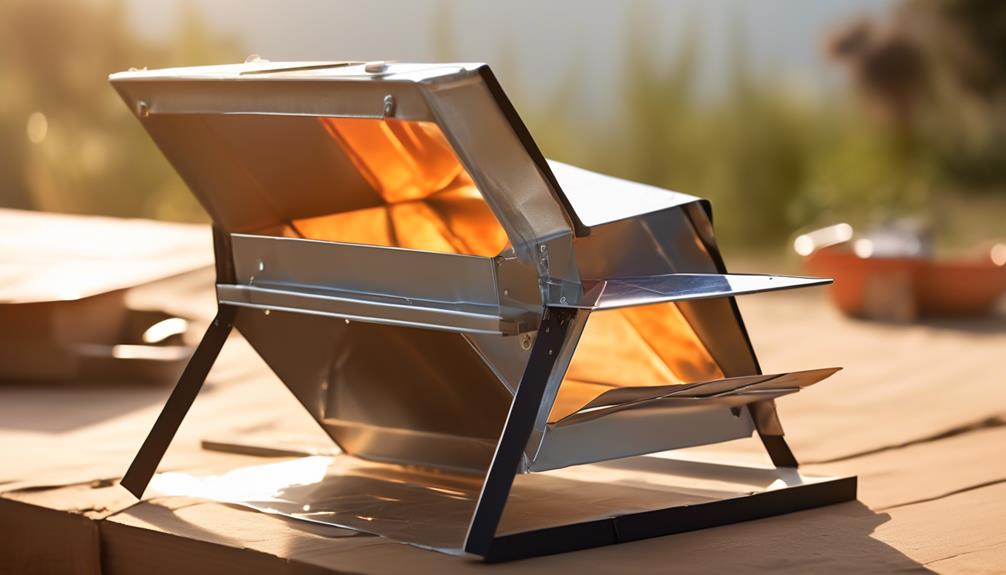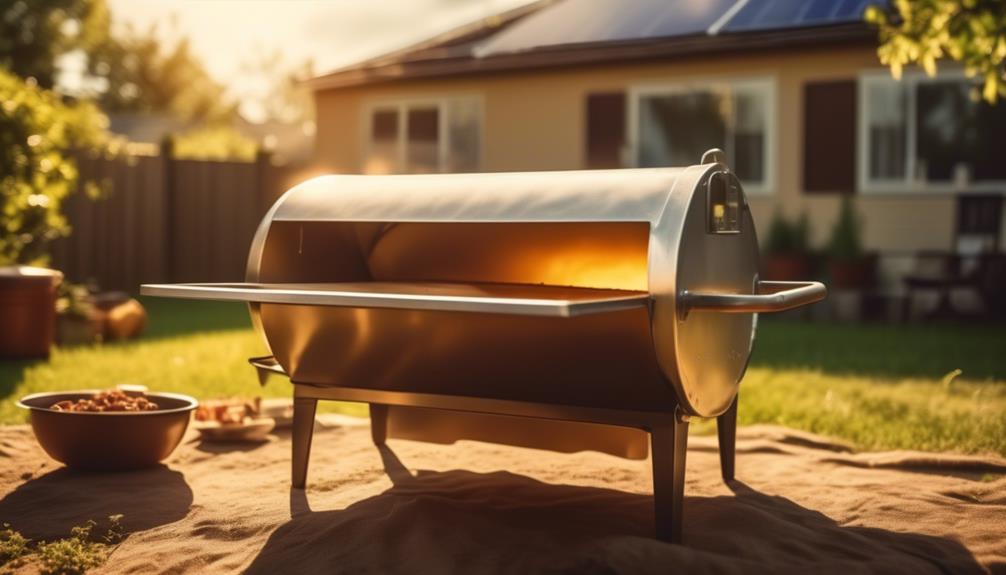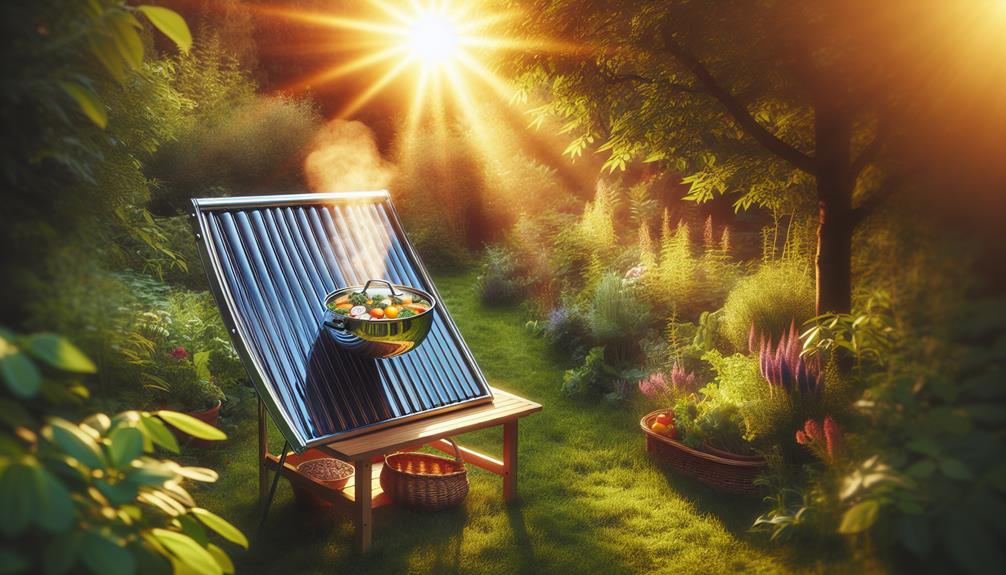When it comes to cooking, there's a whole world of possibilities waiting to be explored. And what better way to embark on this culinary adventure than by tapping into the sun's boundless energy?
Solar cooking has emerged as a fascinating and sustainable way to prepare meals, and in this article, we'll uncover the secrets behind this ancient art. From the science behind solar ovens to the practical tips for successful solar cooking, we'll delve into everything you need to know to unleash the sun's power and master the art of solar cooking.
So, get ready to discover a whole new way of culinary creativity that's as environmentally friendly as it is delicious.
Key Takeaways
- Solar ovens use reflective surfaces to concentrate sunlight onto a cooking chamber, allowing them to reach high temperatures for cooking.
- Factors to consider when buying a solar oven include the type of design, accessories, and personal cooking needs and preferences.
- Building a solar oven can be a fun and rewarding project that allows you to cook using the power of the sun.
- Selecting the right pots and pans, made of dark-colored materials with good heat conducting properties, is essential for achieving optimal results in solar cooking.
Basics of Solar Ovens
When it comes to understanding the basics of solar ovens, it's essential to grasp how these innovative cooking devices harness the power of the sun to prepare delicious meals.
Solar ovens work by using reflective surfaces to concentrate sunlight onto a cooking chamber, trapping the heat inside. This design allows the oven to reach high temperatures, typically ranging from 250 to 400 degrees Fahrenheit.
The temperature inside the oven can be controlled by adjusting the angle of the reflectors or using a heat trap. Cooking times in solar ovens can vary depending on factors such as the intensity of sunlight, the type of food being cooked, and the desired level of doneness.
Generally, solar ovens take longer to cook compared to conventional ovens, but they provide a sustainable and environmentally friendly method of cooking.
Factors to Consider When Buying
When purchasing a solar oven, it is crucial to carefully consider a variety of factors to ensure that you select the right model for your cooking needs and preferences. To assist you in making an informed decision, I have compiled a table below that highlights the common accessories and best solar oven designs available in the market.
| Common Accessories | Best Solar Oven Designs |
|---|---|
| Reflectors | Box Cooker |
| Thermometer | Parabolic Cooker |
| Cooking Rack | Panel Cooker |
| Pots and Pans | Tube Cooker |
| Oven Mitts | Hybrid Cooker |
Steps for Building a Solar Oven

After considering the factors for buying a solar oven, it's now time to explore the steps involved in building your own solar oven. Building a solar oven can be a fun and rewarding project that allows you to harness the power of the sun for cooking.
Here are the steps to get you started:
- Gather the materials: You'll need a cardboard box, aluminum foil, a piece of glass or clear plastic, black paint, and insulation materials such as newspaper or hay.
- Prepare the box: Cut a flap in the top of the box and cover it with aluminum foil. Paint the interior of the box black to absorb the sunlight.
- Create the reflectors: Cut two pieces of cardboard and cover them with aluminum foil. Attach them to the sides of the box at an angle to reflect sunlight into the box.
- Insulate the box: Line the inside of the box with insulation material to retain heat.
With these simple steps, you can build your own solar oven and start cooking with the power of the sun. FAQs about solar oven temperature and adjusting a solar oven can be addressed along the way to ensure optimal cooking results.
Now, let's unleash the sun's power and master the art of solar cooking!
Pots and Pans for Solar Cooking
To achieve optimal results when solar cooking, selecting the right pots and pans is essential.
When it comes to pots and pans for solar cooking, there are a few important factors to consider. Firstly, the material of the cookware is crucial. The best materials for pots and pans in solar cooking are those that are dark in color and have good heat conducting properties, such as cast iron or stainless steel. These materials absorb and retain heat effectively, allowing for even cooking.
Additionally, it's important to choose pots and pans with tight-fitting lids to minimize heat loss. Stirring techniques are also important in solar cooking to ensure that the food is evenly cooked. Stirring every 30 minutes or so helps distribute the heat and prevents hot spots.
Solar Oven Pros and Cons

To fully understand the advantages and disadvantages of solar ovens, it's important to evaluate their pros and cons in relation to selecting the right pots and pans for solar cooking. Here are the key points to consider:
- Solar Oven Efficiency:
- Solar ovens harness the power of the sun, making them an eco-friendly and renewable energy source for cooking.
- They can reach temperatures of up to 350°F, allowing for a wide range of cooking options.
- Solar ovens require minimal maintenance and have low operating costs, making them a cost-effective choice.
- Environmental Impact:
- Solar cooking reduces reliance on fossil fuels, decreasing carbon emissions and air pollution.
- By using solar ovens, you contribute to a cleaner and greener planet.
- Solar cooking also helps conserve natural resources by minimizing the need for traditional cooking methods that rely on non-renewable energy sources.
Additional Information and Tips
When considering solar cooking, it's important to be aware of additional information and tips that can enhance your experience and maximize the efficiency of your solar oven.
To address common queries, consult the Solar Oven FAQ section, which provides answers to questions about using and maintaining your solar oven.
In terms of adjusting a solar oven, it's crucial to properly align the reflectors to optimize sunlight absorption. Regularly checking the oven's position throughout the day is recommended, as the sun's angle changes.
Additionally, adjusting the tilt of the oven can help achieve the desired temperature. It's also useful to experiment with different cooking times and temperatures to achieve the desired results.
Remember to preheat your solar oven, choose the right pots and pans, stir food occasionally, and consider cooking multiple dishes simultaneously to make the most of your solar cooking experience.
Frequently Asked Questions
Can I Use a Solar Oven to Bake Bread or Other Baked Goods?
Yes, you can use a solar oven to bake bread and other baked goods. There are many solar oven recipes for desserts available that can help you unleash the sun's power for delicious treats.
Are There Any Safety Concerns When Using a Solar Oven?
There are potential risks when using a solar oven, such as burns from hot surfaces and fires caused by flammable materials. To ensure safety, follow safety precautions like wearing protective gloves and keeping flammable items away from the oven.
Can a Solar Oven Be Used During Cloudy or Rainy Days?
Yes, a solar oven can be used on cloudy or rainy days, although it may take longer to cook. In emergencies, alternative cooking methods like a gas stove or portable grill can be used.
How Long Does It Take to Cook Food in a Solar Oven Compared to a Conventional Oven?
Solar cooking is a game-changer, cooking time is longer compared to a conventional oven, but the benefits are worth it. Harnessing the sun's power is like tapping into a limitless energy source, creating delicious meals with zero emissions.
Is It Possible to Use a Solar Oven for Canning or Preserving Food?
Yes, it is possible to use a solar oven for canning or preserving food. Canning in a solar oven has many benefits, including energy efficiency and an alternative to traditional canning methods.
Conclusion
In the world of solar cooking, the sun becomes your culinary partner, providing a clean and sustainable source of energy. Just imagine, a meal cooked using nothing but the power of the sun's rays. It's like harnessing a beam of light to create delicious and eco-friendly dishes.
So why not unleash the sun's power and master the art of solar cooking? With a solar oven, you can embark on an exciting journey towards a more sustainable and flavorful way of preparing food.

